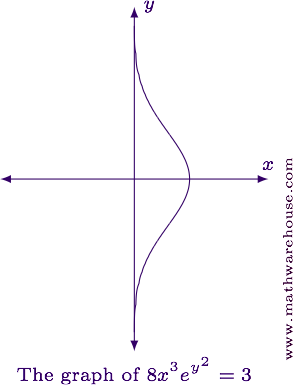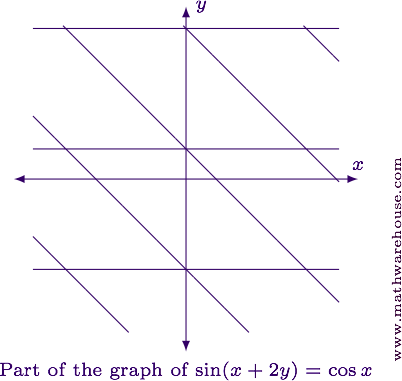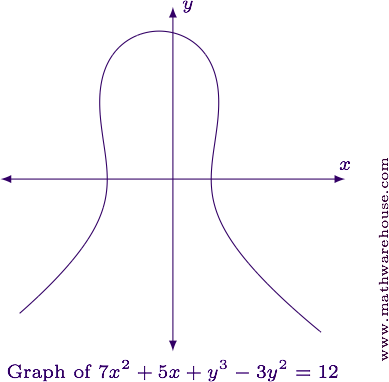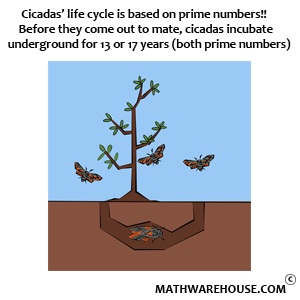Quick Overview
- Implicit differentiation allows us to find derivatives of implicit curves.
- Implicit differentiation relies on the chain rule.
Implicit and Explicit Functions
Explicit Functions: When a function is written so that the dependent variable is isolated on one side of the equation, we call it an explicit function.
That is, an explicit function is written $$y = f(x)$$. All of the functions that we've worked with so far have been explicit.
Implicit Functions: When the dependent variable is not isolated, we refer to the equation as being implicitly defined and the $$y$$-variable as an implicit function.
Circles, Ellipses and Hyperbolas
You are probably most familiar with implicit functions that describe the conic sections: circles, ellipses and hyperbolas.
The graphs of each of these is shown below. Notice how each equation can't be solved explicitly for $$y$$.

Differentiating Implicitly---Basic Idea
If $$y$$ is a function, then $$f(y)$$ is a composite function. That means finding the derivative of $$f(y)$$ requires the chain rule, like this:
$$\frac d {dx}\big(f(y)\big) = f'(y)\cdot \frac{dy}{dx}.$$
Examples
Example 1
Suppose $$f(y) = y^3$$. Evaluate $$\displaystyle \frac d {dx}\left(y^3\right)$$..
Answer$$ \frac d {dx}\left(y^3\right) = 3y^2\cdot \frac{dy}{dx} $$
Example 2
Evaluate $$\displaystyle \frac d {dx}\left(\sin y\right)$$.
Answer$$ \frac d {dx}\left(\sin y\right) = (\cos y)\,\frac{dy}{dx} $$
This use of the chain rule is the basic idea behind implicit differentiation. Usually, we work with implicit equations. We just have to remember to use the chain rule when differentiating something involving $$y$$.
Example 3
Find $$\frac{dy}{dx}$$ for the circle $$x^2 + y^2 = 1$$.
Step 1Differentiate implicitly. Remember, this means $$y$$ is a function, so its derivative is $$\frac{dy}{dx}$$.
$$ \begin{align*} \frac d {dx}(x^2) + \frac d {dx}(y^2) & = \frac d {dx}(1)\\[6pt] 2x + 2y\cdot \frac{dy}{dx} & = 0 \end{align*} $$
Step 2Solve the equation for $$\frac{dy}{dx}$$.
$$ \begin{align*} 2x + 2y\cdot \frac{dy}{dx} & = 0\\[6pt] 2y\cdot\frac{dy}{dx} & = - 2x\\[6pt] \frac{dy}{dx} & = -\frac{2x}{2y}\\[6pt] \frac{dy}{dx} & = - \frac x y \end{align*} $$
Answer$$ \displaystyle \frac{dy}{dx} = -\frac x y $$
Example 4
The graph of $$8x^3e^{y^2} = 3$$ is shown below. Find $$\displaystyle \frac{dy}{dx}$$.
 Step 1
Step 1
Notice that the left-hand side is a product, so we will need to use the the product rule. Identify the factors that make up the left-hand side.
$$ \blue{8x^3}\cdot \red{e^{y^2}} = 3 $$
Step 2Differentiate using the the product rule and implicit differentiation.
$$ \begin{align*}% \blue{24x^2}\cdot e^{y^2} + 8x^3\cdot \red{e^{y^2}\cdot \frac d {dx}\left(y^2\right)} & = 0\\[6pt] 24x^2e^{y^2} + 8x^3e^{y^2}\cdot \red{2y\,\frac{dy}{dx}} & = 0\\[6pt] 24x^2e^{y^2} + 16x^3y\,e^{y^2}\,\frac{dy}{dx} & = 0 \end{align*} $$
Step 3Solve the equation for $$\frac{dy}{dx}$$.
$$ \begin{align*} 24x^2e^{y^2} + 16x^3y\,e^{y^2}\,\frac{dy}{dx} & = 0\\[6pt] 16x^3y\,e^{y^2}\,\frac{dy}{dx} & = -24x^2e^{y^2}\\[6pt] \frac{dy}{dx} & = -\frac{24x^2e^{y^2}}{16x^3y\,e^{y^2}} \end{align*} $$
Step 4Simplify.
$$ \begin{align*} \frac{dy}{dx} & = -\frac{24x^2e^{y^2}}{16x^3y\,e^{y^2}}\\[6pt] & = -\frac 3 {2xy} \end{align*} $$
Answer$$ \displaystyle \frac{dy}{dx} = -\frac 3 {2xy} $$
Example 5
The graph of $$\sin(x + 2y) = \cos x$$ is shown below. Find $$\displaystyle \frac{dy}{dx}$$.
 Step 1
Step 1
Differentiate using implicit differentiation.
$$ \cos(x + 2y)\cdot\left(1 + 2\,\frac{dy}{dx}\right) = -\sin x $$
Step 2Distribute the cosine.
$$ \cos(x + 2y) + 2\cos(x + 2y)\frac{dy}{dx} = -\sin x $$
Step 3Solve the equation for $$\frac{dy}{dx}$$.
$$ \begin{align*} \cos(x + 2y) + 2\cos(x + 2y)\frac{dy}{dx} & = -\sin x\\[6pt] 2\cos(x + 2y)\frac{dy}{dx} & = -\sin x - \cos(x + 2y)\\[6pt] \frac{dy}{dx} & = \frac{-\sin x - \cos(x + 2y)}{2\cos(x + 2y)}\\[6pt] \frac{dy}{dx} & = -\frac{\sin x + \cos(x + 2y)}{2\cos(x + 2y)} \end{align*} $$
Answer$$ \displaystyle \frac{dy}{dx} = -\frac{\sin x + \cos(x + 2y)}{2\cos(x + 2y)} $$
Example 6
The graph of $$7x^2 + 5x + y^3 - 3y^2 = 12$$ is shown below. Find $$\frac{dy}{dx}$$.
 Step 1
Step 1
Differentiate implicitly.
$$ 14x + 5 + 3y^2\,\frac{dy}{dx} - 6y\,\frac{dy}{dx} = 0 $$
Step 2Isolate the terms with $$\frac{dy}{dx}$$
$$ 3y^2\,\frac{dy}{dx} - 6y\,\frac{dy}{dx} = -14x - 5 $$
Step 3Factor out the $$\frac{dy}{dx}$$.
$$ \frac{dy}{dx}\left(3y^2 - 6y\right) = -14x - 5 $$
Step 4Solve for $$\frac{dy}{dx}$$.
$$ \frac{dy}{dx} = \frac{-14x - 5}{3y^2 - 6y} $$
Step 5Simplify.
$$ \begin{align*} \frac{dy}{dx} & = \frac{-14x - 5}{3y^2 - 6y}\\[6pt] & = \frac{-(14x + 5)}{-(-3y^2 + 6y)}\\[6pt] & = \frac{14x + 5}{-3y^2 + 6y}\\[6pt] & = \frac{14x + 5}{6y - 3y^2} \end{align*} $$
Answer$$ \displaystyle \frac{dy}{dx} = \frac{14x + 5}{6y - 3y^2} $$
Example 7
Find $$\frac{d^2y}{dx^2}$$ for the equation shown below.
$$x^2 + y^2 = 16$$
Step 1Find the first derivative $$\frac{dy}{dx}$$.
In Example 1 we determined that $$\frac{dy}{dx} = -\frac x y$$.
Step 2Differentiate again. Notice that the right-hand side will require the quotient rule.
$$ \begin{align*} \frac{d^2y}{dx^2} & = -\frac{y(1) - x\cdot\frac{dy}{dx}}{y^2}\\[6pt] & = -\frac{y - x\cdot\frac{dy}{dx}}{y^2} \end{align*} $$
Step 3Replace $$\frac{dy}{dx}$$ with what it is equal to.
$$ \begin{align*} \frac{d^2y}{dx^2} & = -\frac{y - x\cdot\blue{\frac{dy}{dx}}}{y^2}\\[6pt] & = -\frac{y - x\cdot\blue{\left(-\frac x y\right)}}{y^2}\\[6pt] & = -\frac{y + \frac{x^2} y}{y^2}\\[6pt] & = -\frac{\left(y + \frac{x^2} y\right)}{y^2}\cdot \red{\frac y y}\\[6pt] & = -\frac{y^2 + x^2}{y^2} \end{align*} $$
Step 4Since $$x^2 + y^2 = 16$$, we can replace the numerator.
$$ \begin{align*} \frac{d^2y}{dx^2} & = -\frac{\blue{x^2 + y^2}}{y^2}\\[6pt] & = -\frac{\blue{16}}{y^2} \end{align*} $$
Answer$$ \displaystyle \frac{d^2y}{dx^2} = -\frac{16}{y^2} $$


















